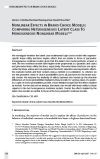
Nonlinear Effects in Brand Choice Models: Comparing Heterogeneous Latent Class to Homogeneous Nonlinear Models
Beitrag, Englisch, 20 Seiten, Schmalenbach Business Review
Herausgeber / Co-Autor: M. Schindler; H. Hruschka
Erscheinungsdatum: 01.04.2007
Seitenangabe: 118-137
Aufrufe gesamt: 921, letzte 30 Tage: 1
We investigate whether the latent class multinomial logit choice model with segmentspecific
linear utility functions implies effects that are similar to those of parametric
homogeneous nonlinear models given that this latent class model performs at least as
well. The two nonlinear models have higher-order polynomial (i.e. quadratic and cubic)
and piecewise linear utility functions, respectively. Piecewise linear functions are represented
by linear splines and can reproduce threshold, saturation and asymmetric effects.
We evaluate models and their variants using a tenfold cross-validation. As criterion we
use the geometric mean of choice probabilities across all purchases for the brand actually
chosen. We measure the similarity of effects between two models by the absolute
differences of choice probabilities implied by these models for varying values of a predictor.
Logits of choice probabilities provide a more detailed insight into the effects implied
by models. For the data set we analyze, the latent class model with linear utility is clearly
superior to the two homogeneous nonlinear models. Overall, the effects implied by the
latent class models are similar to those of the two parametric nonlinear models.
Keywords: Multinomial Logit, Brand Choice, Latent Class, Paneldata, Consumer Behavior, Nonlinear Model, Estimation using R (S-Plus)


